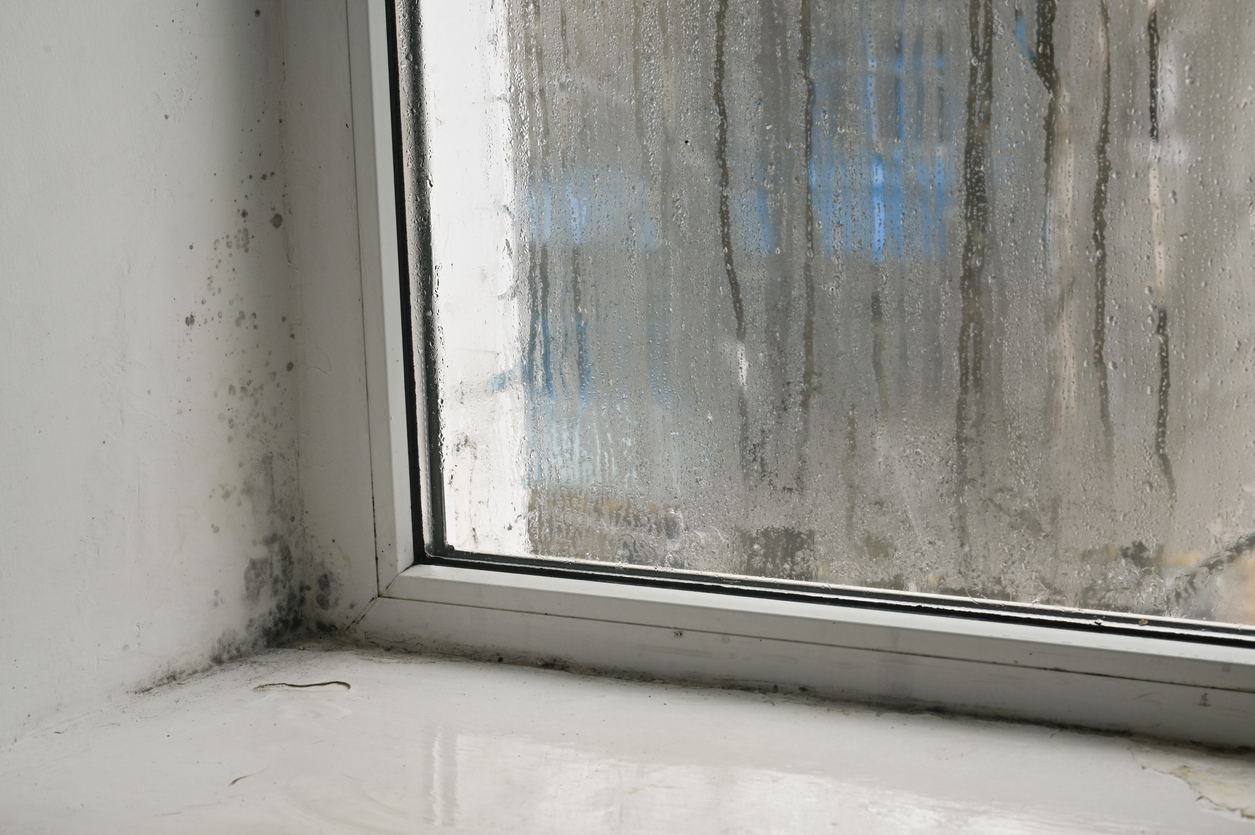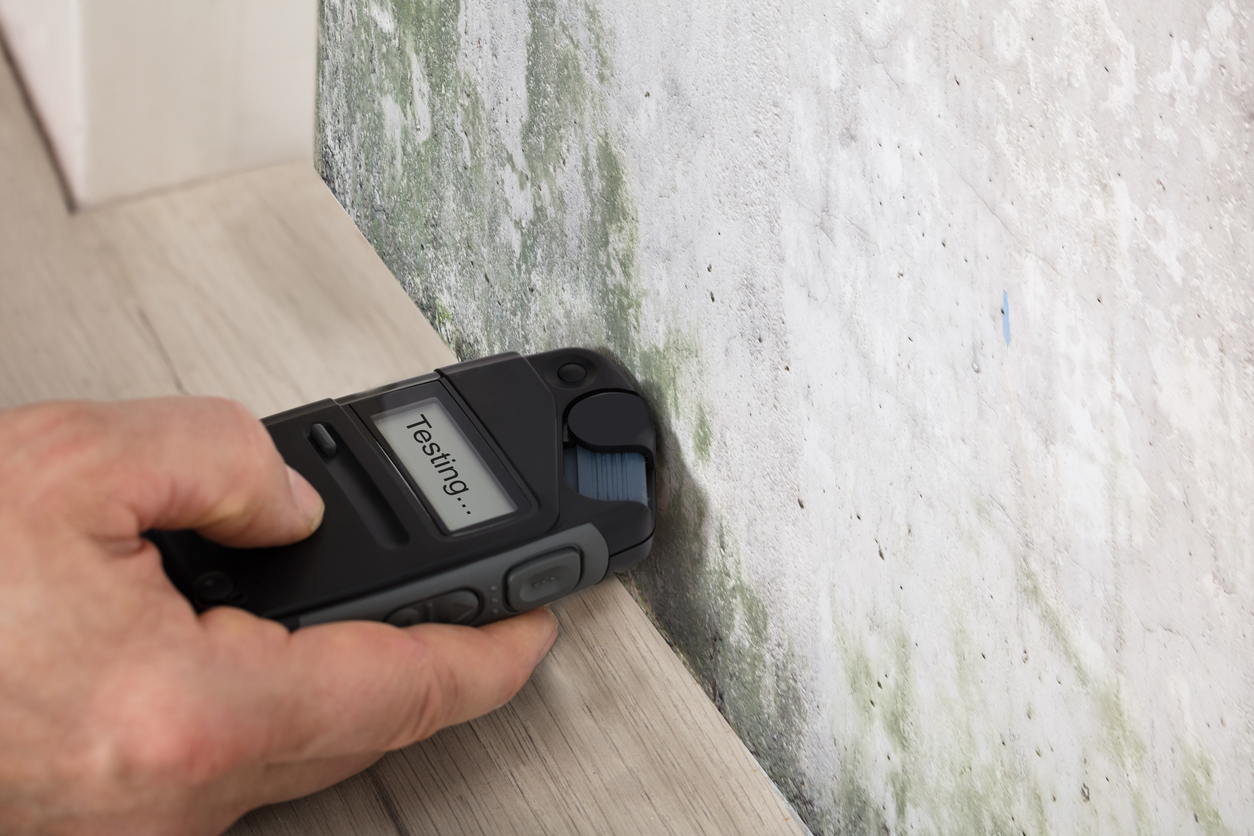We may earn revenue from the products available on this page and participate in affiliate programs. Learn More ›
Q: It’s been pretty humid outside, and lately I’ve noticed a musty smell in certain parts of my house. I’ve also been experiencing allergy-like symptoms like sneezing and coughing. Could mold be the culprit, and what signs of mold in the house should I be looking for?
A: Mold is a stealthy intruder that can damage a home and negatively affect its occupants. For many, the mere suspicion of mold infestation brings with it worries of health concerns, property damage, and costly remediation. Recognizing the early signs of mold in a house can be the key for its occupants to prevent a minor issue from becoming a major headache.
For those wondering whether there might be mold growing somewhere in their home, there are a few major signs to be aware of.
While mold growth is clear evidence of a problem, the first signs of mold in the home are not necessarily visible. A musty or damp smell can indicate that mold is growing somewhere out of sight.
The overt appearance of mold, which is marked by green, black, or white patches on surfaces, is undeniable proof of an infestation. However, many of the initial indicators of mold’s presence are more subtle. One of the early signs is the smell of mold throughout the home, especially in spaces prone to moisture, such as bathrooms, basements, and kitchens. This musty scent, reminiscent of old books or wet socks, signals the metabolic process of mold as it feeds on organic materials like wood, wallpaper, or carpet. While a mold smell in the house may not be pronounced at first, it is likely to become more pungent the more advanced the mold growth becomes.
Health-related symptoms that mimic seasonal allergies can be one of the first signs of mold growing in the home; symptoms may be more severe for those with conditions like asthma.
Recurring health issues that feel like a bad bout of seasonal allergies might, in fact, be the body’s response to mold exposure. According to the Environmental Protection Agency (EPA), such symptoms can include:
- Watery eyes
- Sneezing
- Itching
- Nasal congestion
- Skin rashes
- Persistent coughs
For those with pre-existing respiratory conditions, the situation can be more serious. Individuals with asthma or other respiratory ailments might experience an exacerbation of their symptoms, ranging from increased wheezing and shortness of breath to more frequent and severe asthma attacks. It’s worth noting that mold mites, which are common where mold growth is present, can cause similar reactions in those who are allergic to them.

Moreover, health effects may vary depending on the type of mold that is present. Toxigenic varieties like black mold produce mycotoxins, which can have more serious health implications when inhaled over a prolonged period. This exposure can lead to neurological problems, fatigue, headaches, and, in extreme cases, immune system suppression or organ damage. The risk is particularly high for vulnerable groups, such as children, older adults, and those with compromised immune systems. It’s important to identify black mold in the house as soon as possible so it can be treated and removed by a professional.
Side effects of mold growth are not restricted to people. If pets exhibit signs of illness or behave strangely, this can be another sign pointing to mold growing in the home.
Mold growth doesn’t just impact the human inhabitants of a home. Pets often have heightened senses compared to humans and might detect and react to mold even before their owners notice anything amiss. They may begin to avoid specific areas of the house that they once frequented if they detect the presence of mold there. Physical symptoms that have no other apparent cause could also be a result of mold.
Mold exposure symptoms in pets can vary but may include:
- Wheezing
- Increased coughing
- Skin irritations
- Constant scratching
- Lethargy
If pets ingest mold, they may also exhibit gastrointestinal symptoms like vomiting. It’s worth noting that because of their smaller sizes, animals may be affected by smaller amounts of mold than their human owners.
Excess moisture is a leading cause of mold, so noticeable humidity or condensation indoors can be a sign that conditions are favorable for mold growth.
Mold spores that are naturally present in the environment can spring to life when they encounter damp conditions in a home. The excess moisture provides mold spores with the water they need to germinate and flourish. When a house feels humid or displays visible condensation on windows, walls, or other surfaces, it’s a signal that conditions are ripe for mold infestation.

Areas in homes that are commonly vulnerable to moisture issues include basements, bathrooms, kitchens, crawl spaces, attics, and the areas around windows or door frames. The moisture accumulation might stem from poor ventilation, leaking roofs or pipes, or groundwater seepage, or it might be due to external factors, such as being in a high rainfall zone. Homes that have been affected by flooding or have unresolved water damage can also become mold hot spots. Removing excess moisture can stop a mold problem from progressing, but the mold itself will need to be removed in order for it to go away completely.
One of the first visible signs of mold is peeling paint or wallpaper when mold grows on the wall underneath.
Mold infestations often begin in the walls of a home, only becoming visible as the growth spreads. The first signs may be subtle bubbling, warping, or wrinkling of the paint or wallpaper. Over time, this can become more pronounced, leading to evident peeling or lifting as moisture becomes trapped between the wall and its exterior surface. While mold is not the only reason for wallpaper separating from the wall, if the area also feels damp then mold is the likely culprit. It may be worth peeling back the wallpaper or scraping away paint in one of the affected areas to check for visible mold growth on the surface of the wall. It isn’t advisable to paint over mold, as the growth is likely to continue to reappear over time.
Discolored spots on the walls and ceiling can also indicate mold, and up close, these spots may appear slimy or fuzzy.
Discoloration that manifests as irregular patches of black, green, brown, or even yellow can be a telltale sign of mold on ceilings and walls. In high-moisture environments, these patches have a slimy texture due to the active growth and feeding of mold colonies. In drier conditions, the same mold might present a fuzzy or powdery appearance, as often appears on the surface of old bread. These visual and tactile properties result from the dense growth of mold hyphae (the branching filaments that make up the main body of the fungus) on the surface.

In kitchens and bathrooms, mold may appear in the form of dark spots on grout or caulk.
Because of frequent water use and the potential for humidity, kitchens and bathrooms are prime territories for mold invasion. Some overlooked spots that are prone to mold growth in these spaces are the grout between tiles and the caulk that seals areas around bathtubs and sinks. Over time, if these areas remain persistently damp or are not adequately cleaned, they can become breeding grounds for mold. The porous nature of grout makes it especially susceptible. The first indication of mold might be dark or discolored specks and patches forming on what was once white or light-colored grout. Similarly, caulk’s flexibility means moisture can be trapped behind it, allowing mold to grow both on its surface and underneath.
Mold spores can be circulated through a home’s ductwork, and a common sign of mold in an HVAC system is growth spots on AC filters.
A home’s heating, ventilation, and air conditioning (HVAC) system plays a pivotal role in ensuring the comfort and air quality of the living space. However, being a conduit for airflow, it can unwittingly become a transporter for mold spores. If mold growth is within the ductwork or in any part of the HVAC system, these spores can be dispersed throughout the home every time the system is on.
One of the earliest indicators of contamination is the appearance of growth spots on air conditioner filters. These filters, which are designed to trap dust, pollen, and other airborne particles, can get clogged with mold spores. Over time, when conditions are right, these trapped spores can begin to grow directly on the filter, appearing as dark, irregular patches. If these signs are observed, mold could potentially be proliferating in other parts of the HVAC system, such as in the drip pans, coils, or within the ducts themselves. Consequently, it’s essential not only to replace the contaminated filter but to also have a comprehensive inspection and cleaning of the entire HVAC system.
In addition to checking for mold in the home’s HVAC system, it might be wise to consider purchasing an air purifier to help address mold issues. Air purifiers equipped with high-efficiency particulate air (HEPA) filters can capture mold spores from the air, preventing them from circulating and settling onto surfaces. Although purchasing an air purifier for mold can reduce airborne mold spores in a house, it won’t address mold growing on surfaces. The root cause of mold is best tackled directly, which could mean improving ventilation, fixing leaks, or using dehumidifiers.
A home mold test can aid in identifying a mold issue, but for the most accurate results, it’s worth scheduling a professional inspection.
The presence of mold in homes often raises concerns, prompting questions about mold detection and severity. While there isn’t a device that actively “detects” mold like a smoke detector detects smoke, one of the best mold testing kits is an option. These kits can be used to collect samples from around the home, which are then sent to a lab for analysis.

Of course, it’s a normal occurrence to have some mold in a home. A typical home, without any signs of water damage or excessive moisture, can still have anywhere between 1 and 1,500 mold spores per cubic meter of air. Elevated levels beyond this range might suggest water damage or an environment conducive to mold growth, warranting further inspection and possible remediation.
Those who have noticed a persistent musty odor; discoloration on walls, ceilings, or other surfaces; or who have experienced allergy-like symptoms can use a test kit to check for mold in the house and confirm its presence. However, it’s highly recommended to call a professional inspector who specializes in testing for mold in a house for an accurate assessment on the severity of the mold problem. The typical cost of a mold inspection is between $295 and $1,010, with a national average of $648.
If mold is indeed present, a remediation company can eliminate the problem and advise on how to prevent it from coming back.
At the unwelcome discovery of mold, a flood of concerns may arise, and for good reason. Continuous mold exposure can have serious health repercussions, especially if the growth is concentrated in bedrooms or living areas where residents spend much of their time. Until a mold remediation service is able to treat the home the Centers for Disease Control and Prevention (CDC) recommends creating a separate “safe” sleeping area in the least-affected room of the house. If possible, it’s a good idea to open a window to allow fresh air circulation and enhance the room’s air quality.
A top mold removal company is able to not only remove mold to address the existing growth, but it can also restore areas that have been damaged. These professionals use specialized equipment and techniques to identify the extent of the mold, remove contaminated materials, and ensure that the living spaces are once again safe. They will also take measures to ensure that mold does not regrow, such as fixing leaks and using dehumidifiers in high-humidity areas. On average, mold remediation costs around $2,254, but this will depend on the size of the home, the extent of the problem, and the type of mold, among other factors.
Fortunately, most mold damage is not permanent. While surfaces like glass, metal, and certain plastics might only need a thorough cleaning, porous materials like drywall, carpet, and upholstery can retain mold spores and might require replacement to ensure complete remediation. The structural integrity of wood can also be compromised if mold has been left untreated for an extended period.
With the right interventions, even extensive mold damage can be repaired, and the home can be restored to its former state. Experts can also offer invaluable advice on moisture management and preventive measures beyond mold removal, ensuring the home remains mold-free in the future.


